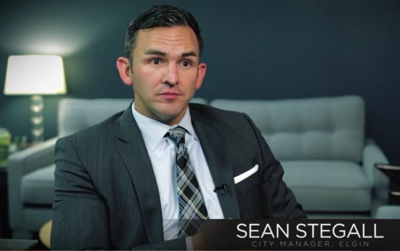Gartner estimates that smart homes will have nearly 300 million connected things in use by 2015. That is a staggering number but what about connected neighborhoods, towns, cities and states? Gartner estimates that 1.1 billion connected things will be in use by smart cities in 2015, growing to nearly 10 billion by 2020.
Here's Gartner's definition of a smart city:
A smart city as an urbanized area where multiple sectors cooperate to achieve sustainable outcomes through the analysis of contextual, real-time information shared among sector-specific information and operational technology systems. -Gartner
Gartner predicts that residential citizens will lead the connected revolution by investing in smart-home solutions which they estimate will exceed 1 billion units by 2017. Here are 40 examples of connected consumer-oriented devices that will add to the smart-home ecosystem.
In addition to home connected things, Gartner also points to on-street and off-street parking guidance, road traffic guidance and traffic flow metering and more, noting that in California, radio receivers and sensors are embedded in highways to monitor and analyze traffic conditions in real-time.
Accenture notes that 'smart city initiatives are often doing the same thing, thinking in evolutionary instead of revolutionary terms'. Accenture states:
By focusing more on the end-user, the citizen, city leaders will be able to:
1. Transform city institutions, making them more agile to deliver even greater value for citizens
2. eet citizen expectations of highly engaging and personalised services through human-centered design
3. Play an active role in opening up city data to foster growth, innovation and improved services
Deloitte's definition of a smart city is:
A city can be defined as 'smart' when investments in human and social capital and traditional (transport) and modern (ICT) communication infrastructure fuel sustainable economic development and a high quality of life, with a wise management of natural resources. - Deloitte
The key words in Deloitte's definition is 'investments in human', 'modern communication infrastructure' and 'high quality of life'.
Connected things are wonderful but ultimately what makes a smart city has to start with connected citizens - to each other and to the city itself. And this starts with improving citizen communication and engagement. Connecting and improving citizen communication is not just for big cities like Boston, New York or San Francisco. Say hello to Elgin, Illinois.
The city council members for Elgin developed a strategy aimed at improving citizen communication and engagement with performance-based results. To achieve their goal, they appointed Sean Stegall as city manager. Stegall knew that in order to drive results, the city would need to invest in a high-performing 311 center of the future, requiring analysis of market best practices, study of organizational behavior and a series of proof-of-concepts and experiments. Ultimately the goal was for the city to transform and adapt to meet the needs of its digital savvy citizens by using intelligent, secure, scalable and high-performance enterprise applications.

Sean Stegall, City Manager - Elgin, Illinois
The smart city vision for Elgin is to connecting the right people, at the right time, to the right information and resources. Stegall and his technology team leader Dan Ault, recognized that the best approach to deliver this vision to invest in a single, highly scalable, adaptive, and available platform that could seamlessly connect multiple departments.
Ault, Senior Management Analyst for the city of Elgin, is responsible for the city's technology planning and implementations. Ault was tasked with implementing the city's 311 center across 19 city departments. I recently met with Ault to learn more about smart cities and their use of mobile, social, app, cloud and data technologies to deliver world-class city-wide customer service.

Dan Ault - Senior Management Analyst, Elgin, Illinois
"Given the technology requirements and the need to optimize resources, the best viable investment was a cloud-based multi-purpose CRM platform with customer service, mobile app development capabilities," said Ault. The platform needed to be cloud-based, mobile and social and integrated.
City of Elgin's cloud architecture had to deliver on three important areas with a single source of truth, allowing city employees to access information and to collaborate:
- Constituent relationship management (example: residents and businesses)
- Address and parcel management (example: location based billing, code enforcement, permitting, licensing, grants, etc.)
- Asset management (example: city infrastructure-signs, streets, sewers, trees, water mains, water meters, buildings, parks etc)
Today, the city of Elgin is delivering new, and supporting traditional services, leveraging a cloud, mobile and social strategy. Adoption of cloud technologies has created an agile environment for Elgin's IT staff - a shift from technology management to use of technology for better management of the customer experience.
Ault said:
Our investment in a cloud-based platform means that we are able to continuously evolve, improve and scale our capabilities. The flexibility of cloud CRM has shattered the contemporary view of technology in cities and how it's managed. The real challenge moving forward is for more cities to recognize and quickly adopt cloud CRM solutions in order to meet the ever-growing expectations of citizens.
The mobile phone is becoming your remote control for life.
At the city of Elgin we wanted to attack this new reality of always connected and mobile citizen both internally and externally. The disruption that mobile brings is really exciting for cities. We've started to use our internal mobile app to complete enterprise functions in a variety of areas. Today the public works departments work order system can be entirely run from a mobile app.
Ault and his team found great benefits from having in-house development resources to enable their mobile innovation roadmap. Knowing that the vast majority of time citizens spend on mobile devices is behind an app (nearly 90% of time), Ault and his team know that building a mobile app is a key element of their communication improvement strategy.
"Our consumer 311 app (available for iOS and Android devices) was seamlessly designed, developed and integrated within our CRM enterprise framework because of our Salesforce.com App Cloud platform investment. This allowed us to easily generate reports and makes it easy for non-developers to update information in the app seamlessly. Our 311 app is not static, feature rich and compatible with all mobile devices that our citizens use," said Ault.
"We didn't want our 311 app to just be a pothole-submitting app (although you can do that). We wanted to truly connect and engage with the community by delivering meaningful information about the city, our services and other relevant news. We integrated social networking feeds into our app under the section "What's Happening" and also offered pushed notifications and bill payment options and permit processing capabilities," said Ault.
The 311 mobile app, powered by Salesforce.com App Cloud enables residents to request city services by simply uploading photos that point to their issues. The app also aggregates social media content from 60+ communities regarding the city.
Ault and his team are creating a high social ecosystem at Elgin, where city employees and citizens are able to collaborate and share up-to-date news, much like an extension to the already existing police and fire radio system, but scaled to a much higher degree. The social connections are helping the city connected what was once disparate silos of information to what can be described today as a well-connected, highly responsive and personalized city communication network.
Information is posted on a variety of channels and can consumed go viral internally to keep employees on the same page. The best part is that it is connected to our enterprise work systems so it is just part of everyday life in the city of Elgin. It was revolutionized how we handle, snow and ice operations, respond to storm events, and manage the day-to-day issues of a city. - Dan Ault
Social citizen engagement goes far beyond just using Facebook or Twitter - which Elgin already actively uses. Social engagement on mobile is now the ability for a developer or permit applicant to interact with city staff by sharing documents on a feed associated with their application.
What advice does Ault have for city IT departments who are beginning their journey to becoming a smart and well-connected city?
It is important for cities to embrace the cloud, and to recognize and adapt to the new reality that it brings. Cities are on the frontline of government. We provide the services that keep life going everyday (water services, road safety, fire and police protection, ambulance service, safe buildings and parks). Our citizens are more connected and have higher expectations in an on-demand economy where the Ubers and Airbnb's of the world are disrupting legacy business and service models.
"Cities all across the country are adopting innovation initiatives to improve citizen communication, engagement and service delivery. But smart city initiatives cannot reach their full potential in a cost-effective, scalable, secure and intelligent manner without city IT adoption of cloud technologies," said Ault.
The innovation from companies like Salesforce.com, Apple and Google can help smart city transform to a highly connected, intelligent and personalized ecosystems. The innovation from these cloud leaders rivals the impact of railroad expansions, steel production that led to robust building and critical bridges, telephone communication and tunneling systems of the past.
Cities must become more like technology companies - developing technology roadmaps, partnerships and key deliverables that advance the quality of life for their citizens. This is the goal for the city of Elgin. We are thinking differently and partnering with the most innovative cloud, mobile, social, community, app and data science providers to help us execute against our smart city transformational objectives.
Elgin will continue to migrate more city operations and services to the cloud under the leadership of Sean Stegall and Dan Ault. This winter, Ault and his team will launch the City's Online Marketplace which overtime will become the Amazon.com style one-stop shopping portal for everything related to the city of Elgin. I will continue to stay in touch with Elgin, sharing their stories as they set the bar for other smart cities to follow.
Watch this video highlighting the use of social collaboration technologies and a robust CRM platform to improve customer service, bolster trust and scale citizen engagement.
SalesForce: City of Elgin from Elsie Lejano on Vimeo.
This post was co-authored by Dan Ault, Senior Management Analyst at the city of Elgin.
